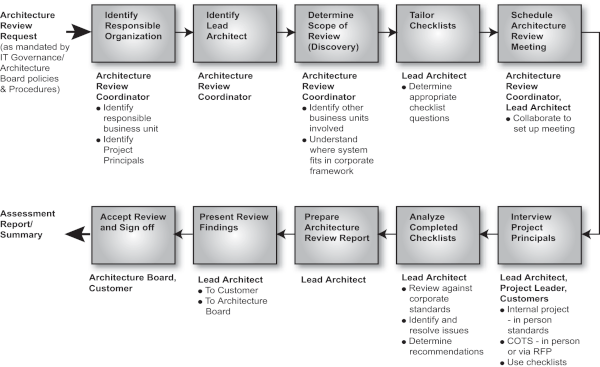
- Name implies in implementation, governance is really you are governing or monitoring the implementation that is being done by others.
- The purpose of Phase G is to ensure that the implementation of the changes are conforming to your design of those implementations.
- Perform Architecture Governance - check that the applied changes affect the business outcomes
- External reference materials
- Request for Architecture Work (Preliminary)
- Capability Assessment (Phase A)
- Organizational Model (Prelim)
- Tailored Architecture Frameworks (Prelim Phase)
- What other frameworks your organization is using and how TOGAF is working with them?
- Approved Statement of Architecture Work (Phase A)
- Architecture Vision (Phase A)
- Architecture Repository
- Architecture Definition Documents and requirements (BDAT)
- Approved version of Architecture Roadmap
- Implmenentation Governance model
- Architecture Contract
- the agreement between you as the architect and the implementation teams and in terms of their work.
- If you have already changes that need to be implemented for the next cycle, that is also an input as well as the approved implementation of migration plan.
- Request for Architecture work on next ADM cycle (Phase F)
- Implementation and Migration Plans (Phase F)
- Confirm Scope and priorities for Deployment.
- So we already laid out a architecture roadmap and then a migration plan.
- Any particular transition architectures?
- Identify Deployment resources and Skills
- Make sure that we have the resources and skills required to do this deployment.
- Guide Development of Solution Deployment
- You're going to act as a guide or someone that you can help in terms of the development team,
- you're obviously not doing the development, but having these ideas of what's important and why they're doing something can actually help.
- Perform Enterprise Architecture Compliance Review
- You're going to do compliance reviews. So if there is a solution that's developed or acquired, it could be off the shelf third party software,
- making sure that that solution complies with your architecture requirements.
- Implement Business and IT operations
- Obviously you've got other teams that are involved besides the development teams
- Perform Post-Implementation Review and Close the implementation
- any changes that need to come are obviously going to be part of a new a new cycle
https://pubs.opengroup.org/architecture/togaf8-doc/arch/chap24.html
https://pubs.opengroup.org/architecture/togaf8-doc/arch/chap24.html
Architecture Governance Techniques
- Architecture Contract
- So this is the a joint agreement between development partners and sponsors, which are your business partners on the deliverables, quality and fitness for purpose of an architecture.
- Compliance Assessment
- You're also going to assess any compliance and so that compliance assessments become part of your outputs if there are change requests.
- Change Request
- So let's say the development team starts to go down a path and then they find that there's an easier solution.
- So they already planned to go out and purchase the third party software and do this API.
- Architecture-Compliant solution deployed
- So they've developed and deployed these solutions and your business is now on a new path, right?
none
